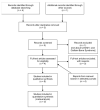COVID-19 and Guillain-Barre Syndrome: a systematic review of case reports
- PMID: 32995555
- PMCID: PMC7509591
- DOI: 10.12688/wellcomeopenres.15987.2
COVID-19 and Guillain-Barre Syndrome: a systematic review of case reports
Abstract
Background: Guillain-Barre Syndrome (GBS) is a neurological autoimmune disease that can lead to respiratory failure and death. Whether COVID-19 patients are at high risk of GBS is unknown. Through a systematic review of case reports, we aimed to summarize the main features of patients with GBS and COVID-19. Methods: Without any restrictions, we searched MEDLINE, Embase, Global Health, Scopus, Web of Science and MedXriv (April 23 rd, 2020). Two reviewers screened and studied titles, abstracts and reports. We extracted information to characterize sociodemographic variables, clinical presentation, laboratory results, treatments and outcomes. Results: Eight reports (n=12 patients) of GBS and COVID-19 were identified; one was a Miller Fisher case. The age ranged between 23 and 77 years, and there were more men (9/102). GBS symptoms started between 5 and 24 days after those of COVID-19. The protein levels in cerebrospinal fluid samples ranged between 40 and 193 mg/dl. None of the cerebrospinal fluid samples tested positive for COVID-19. Six patients debuted with ascendant weakness and three with facial weakness. Five patients had favourable evolution, four remained with relevant symptoms or required critical care and one died; the Miller Fisher case had successful resolution. Conclusions: GBS is emerging as a disease that may appear in COVID-19 patients. Although limited, preliminary evidence appears to suggest that GBS occurs after COVID-19 onset. Practitioners and investigators should have GBS in mind as they look after COVID-19 patients and conduct research on novel aspects of COVID-19. Comparison with GBS patients in the context of another viral outbreak (Zika), revealed similarities and differences that deserves further scrutiny and epidemiological studies.
Keywords: COVID-19; Guillain-Barre Syndrome; neurological complications; pandemic.
Copyright: © 2020 Carrillo-Larco RM et al.
Conflict of interest statement
No competing interests were disclosed.
References
Publication types
Associated data
LinkOut - more resources
Full Text Sources
Miscellaneous


